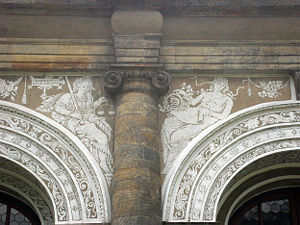Prague
Prague (in Czech: Praha) is the capital city of the Czech Republic. It has served as the capital city of Czechoslovakia, as well as the centre of the Bohemian kingdom, since the ninth century. Today, the city of Prague is divided in 57 municipal districts and 22 administrative districts.[1] The capital is headed by the Mayor, Pavel Bem, and the population consists of approximately 1,160,000 residents. [2]
Many significant architectural styles can be seen in Prague, and the historic centre of Prague is on UNESCO's World Heritage List.[3] Most significant architecture in the historic centre was built in the 14th century under the patronage Holy Roman Emperor Charles IV. The city plays host to a range of suceeding styles, particularly that of the Baroque, and also includes a fine example of Cubist architecture.
Significant structures in Prague are the Charles Bridge (Karlův most), the Prague Castle (Pražský hrad),[4] as well as the Old Town, Lesser Town and the Jewish quarter. It also is the location of the Klementium and the Karolinum (Universita Karlova, or Charles University), which was founded in 1348 and is the oldest university north of the Alps.[5]
History of Prague
As a developing area, the initial township that was to become Prague was situated on a hill overlooking the Vltava River, with the primary defensive structures ideally placed to overlook the valley to the north east and the curve of the river to the east. Prior to the building of the Charles Bridge, Prague was connected to the eastern bank by several wooden bridges. After the Judith Bridge was washed away in flooding, Charles IV commissioned a stone bridge as a testament to his reign and to signify the financial, cultural and architectural dominance of his city. Some remnants of what was the Judith Bridge remain on the western bank of the city.
Structural Damage and Repair after World War II
While relatively undamaged after occupation by the Germans and liberation by the Russians, some structural damage has resulted in new and interesting buildings and features.
Upon the expulsion of the occupying German troops from Prague, the defeated army set up their tanks in a line facing the town hall in the Old Town Square, destroying a part of the town hall. Whilst the famous tower containing the Astronomical Clock remained intact, the demolished building has not been rebuilt or replaced, instead leaving the area as an open market, bazaar and meeting place in order to commemorate the incident.
Along Na Příkape, structural damage to one of its heritage buildings resulted in a debate as to whether or not to reconstruct a building in the fashion of the 17th-18th century buildings in a neoclassical style. A more modernist proposal was created, leading to a glass facade which is structurally in line with the older buildings, and now houses a mall.
Damage to the Míčovna, or Ball-Game House, located near the Prague Castle, led to some interesting cosmetic changes. Where the sgrafito facade previously featured the virtues, under the auspices of communism, the repaired section of the facade visually placed the virtue of the Five-Year-Plan next to the natural virtues of temperance, justice, peace and justice.
References
- ↑ Prague City Hall (English language)
- ↑ Statistical Yearbook of the City of Prague, 2005
- ↑ UNESCO World Heritage Sites: Prague
- ↑ Příběh Pražského Hradu (in English: History of Prague Castle), Správa Pražského hradu, 2003. Czech Edition ISBN 80-86161-72-2 English Edition ISBN 80-86161-73-0
- ↑ Universita Karlova
